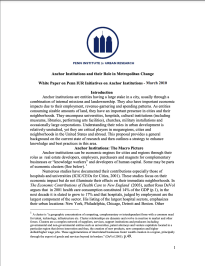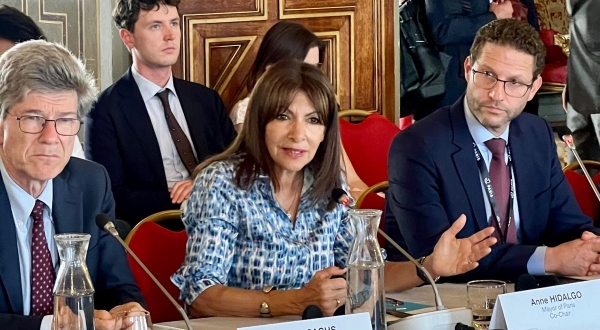Key Message
Anchor institutions are pivotal to the economic and social vitality of metropolitan areas, serving as drivers of development and stability in their regions. The report highlights the dual roles of anchor institutions in promoting economic growth and addressing urban challenges. By leveraging their significant resources, anchor institutions can initiate and sustain neighborhood revitalization efforts, enhance local economic opportunities, and foster community engagement. The case studies illustrate various successful models of collaboration between anchor institutions and local governments, showcasing how targeted investments in infrastructure, education, and public services can lead to sustainable urban development. However, the report also acknowledges the complexities and potential conflicts that arise when aligning the interests of anchor institutions with those of surrounding communities. Effective strategies for maximizing the positive impact of anchor institutions include fostering partnerships across sectors, implementing policies that support equitable development, and continuously evaluating the outcomes of anchor-led initiatives. The ongoing research at Penn IUR aims to deepen the understanding of best practices and innovative approaches to harnessing the potential of anchor institutions for metropolitan change, ultimately contributing to more resilient, inclusive, and dynamic urban environments.
Introduction
Anchor institutions are entities having a large stake in a city, usually through a combination of internal missions and landownership. They also have important economic impacts due to their employment, revenue-garnering and spending patterns. As entities consuming sizable amounts of land, they have an important presence in cities and their neighborhoods. They encompass universities, hospitals, cultural institutions (including museums, libraries, performing arts facilities), churches, military installations and occasionally large corporations. Understanding their roles in urban development is relatively unstudied, yet they are critical players in megaregions, cities and neighborhoods in the United States and abroad. This proposal provides a general background on the current state of research and then outlines a strategy to enhance knowledge and best practices in this area.
Anchor Institutions: The Macro Picture
Anchor institutions can be economic engines for cities and regions through their roles as real estate developers, employers, purchasers and magnets for complementary businesses or “knowledge workers” and developers of human capital. Some may be parts of economic clusters (See below).1
Numerous studies have documented their contributions especially those of hospitals and universities (ICIC/CEOs for Cities, 2001). These studies focus on their economic impact but do not illuminate their effects on their immediate neighborhoods. In The Economic Contributions of Health Care to New England (2003), author Ross DeVol argues that in 2001 health care consumption constituted 14% of the GDP (p.1), in the next decade it is slated to grow to 17% and that hospitals, judged by employment are the largest component of the sector. His listing of the largest hospital sectors, emphasizes their urban locations: New York, Philadelphia, Chicago, Detroit and Boston. Other studies focusing on universities such as Universities and the Development of Industry Clusters (2004) by Jerry Paytas dissect the internal workings of universities revealing the association of complementary businesses while the authors of Engines of Economic Growth, The Economic Impact of Boston’s Eight Research Universities on Boston’s Metropolitan Area (2003), highlight research universities’ contributions in terms of their employment (more than the city’s financial services industry), the dollar amount of their payrolls, purchasing and construction ($7 billion in 2000) and their attraction of capital from outside the region (approximately $4 billion).While the importance of arts anchor institutions is less studied, a recent effort, Culture Builds New York, The Economic Impact of Capital Construction at New York City Cultural Institutions tracks the level ($1.8 billion) of direct capital expenditures and their multiplier effects ($2.3 billion) (Lanier, 2003). In addition, the popular press is now tracking the importance of combined eds/meds/arts districts exemplified by recent New York Times’ coverage of Cleveland’s University Circle (Chamberlain, 2006).
In U. S. cities, with the loss of manufacturing and the substitution of the service and knowledge industries, anchor institutions have emerged as important elements of this constellation. And some municipalities have turned to anchor institutions as one means for re-invention with varying results. While Pittsburgh announced such a strategy more than twenty years ago, others are just now organizing such campaigns. In Phoenix, San Francisco and Miami universities and medical centers are the center pieces of downtown redevelopment. In Atlanta, the Atlanta University Consortium (Morehouse, Spelman, Morris Brown colleges and Clark Atlanta University) is engaged in developing a 40-census tract mixed- use corridor incorporating life sciences and technology research facilities, retail, residential and other institutional uses designed to strengthen the institutions and the deteriorated neighborhoods in which they are located. The city has already seen success with university-driven downtown and neighborhood revitalization through the work of Georgia State University and Georgia Tech. (Perry and Wiewal, 2005).
While most studies of anchor institutions have focused on the United States, anchor institutions exist worldwide. Research documenting their development, their impact or their best practice lessons for others is emerging as exemplified by Anamaria de Aragao Costa-Martins and Melchior Sawaya Neto’s The Impact of University Campuses in Disperse Urban Contexts: Case Study of Brasilia, Brazil (2006). Driven by the need to compete in the global economy, many countries have focused national economic development strategies on anchor-institution investment, especially on universities and related businesses often incorporating technology parks and health facilities. While China presents some of the most powerful examples, other countries such as Sri Lanka, Thailand and Belgium also provide examples (Pieprz 2006).
- A cluster is “a geographic concentration of competing, complementary or interdependent firms with a common need for talent, technology, infrastructure etc. Cluster relationships are dynamic and evolve in reaction to market and other forces. Clusters are a complex network of suppliers, services, support institutions and producers including governmental and non-governmental entities such as universities, patent attorneys and venture capitalists located in a particular region that drives innovation and thus, the creation of new products, new companies and higher skilled/higher wage jobs. These agglomerations of interrelated businesses foster wealth creation in a region, principally through the export of goods and services beyond its borders.” (DeVol 2005). p.49.
Anchor Institutions: The Micro Picture
Since anchor institutions have fixed locations in a city, they can play important roles in urban development. Depending on conditions, they may serve as growth poles energizing their surroundings or as enclaves, isolated from their neighborhoods. Understanding these situations is a complex undertaking. While they offer the broad economic advantages discussed earlier, in operating at the local level, they have mixed results: they can bring about important physical and social changes but insodoing they can be the locus of tension and conflict (Willis 2006). They have location-specific requirements for physical space to accommodate buildings and parking, for municipal services including police and fire protection and others and for efficient circulation for their users or suppliers. They have general, less location-specific needs for housing or other associated amenities. Finally, their direct contributions to municipal property tax revenues is limited due to their tax-exempt status as non-profit organizations (a phenomenon they frequently offset by making payments-in-lieu of taxes [PILOTS]) and they do not represent a large block of votes, conditions that can foster strained relationships with elected officials. Issues arise when the interests of anchor institutions collide with those of nearby residents.
Functioning as economically viable entities and balancing their positive and negative qualities pose challenges for anchor institution leaders and their partners including public officials, clients and neighbors. While under optimum conditions, anchor institutions serve as catalysts for improved urban conditions in their regions, home cities and immediate neighborhoods, their ability to contribute to these economies is dependent on the many factors discussed above. Furthermore, anchor institution missions may or may not include explicit service to their immediate neighborhoods. A hospital, for example, has an obligation to respond to the health needs of nearby residents while a university does not necessarily have this function. However, aligning missions – that of institutional survival and growth – with neighborhood stability or revitalization yields desirable results. The challenge is finding ways to achieve and support this goal. Over time, some anchor institutions have accomplished this end, pushed (or enabled) by external circumstances and/or led by visionary chief executives. In the educational arena well-documented examples include University of Pennsylvania’s West Philadelphia Initiatives, Georgia State’s downtown renewal and Ryerson Institute’s revival of Toronto’s Dundas Square (Perry and Wiewal, 2005). Less understood are systematic conditions that could unleash positive anchor-institution initiatives. For example, hospitals stressed by runaway costs and popular demand for emergency room services have begun to develop service dispersion policies. For example, Miami’s Jackson Memorial Hospital is building xx neighborhood clinics to provide early primary care and ameliorate emergency room overcrowding. Newark area hospitals are embarking on a similar program.
Through the work of the City, Land and University initiative of the Lincoln Institute of Land Policy and occasional monographs such as Out of the Ivory Tower and Into the Streets (2007) by Judith Rodin, former president, University of Pennsylvania, research on the role of anchor institutions is beginning to focus on the local redevelopment potential and issues of anchor institutions. The Lincoln and Rodin efforts are extremely important as they lay the foundation for additional work, an approach that widens the definition of anchor institutions, probes more deeply the problems related to their roles in urban development and incorporates international dimensions.
oles in urban development and incorporates international dimensions. Recently, more publications covering the same themes have emerged. They include Anchor Institution Toolkit, A Guide for Neighborhood Revitalization (Netter Center for Community Partnerships 2008), Chapter 8 “Anchor Institutions As Partners in Building Successful Communities and Local Economies” in Brophy and Godsil’s Retooling HUD for Catalytic Federal Government, A Report to Secretary Shaun Donavan (2009), Anchoring Growth: The Role of Anchor Institutions in the Regeneration of UK Cities (The Work Foundation 2009) and How To Behave Like an Anchor Institution (CEOs for Cities 2010). While much work focuses on the universities and hospitals there is a growing consciousness of the importance of other types of anchors. For example, James Cuno’s Whose Muse? (2004) and other works by museum leaders begin to discuss the role of museums as anchors.
New Directions in Anchor Institution Research
Building on this foundation, Penn IUR is engaged in exploring in-depth technical questions revolving around anchor institutions and the spatial dimensions of their development. It involves practitioners, public decision-makers. It inserts evaluation and outcomes assessment as well as technical discussions. The program, a long term project, revolves around three functions: first, measuring the existence and the extent of the impacts of anchor institutions on their neighborhoods, examining the phenomenon in the U.S. and internationally; second, identifying critical problems and solutions, translating the details of these activities into replicable practices and disseminating them effectively; third, monitoring the transferal of these practices beyond the original sources.
This effort broadly focuses on the following tasks:
- Development of indices or measures of anchor institution impacts on immediate neighborhood employing social spatial statistics and other evaluative techniques to monitor baseline conditions and ongoing changes;
- Exploration of policy and managerial tools (of the institution and of the “intersecting bodies” such as government, private sector partners) needed to accomplish the twin goals of anchor institution viability and neighborhood development or redevelopment;
- Discovery and dissemination of best and worst practices and analysis of successes and failures;
To accomplish these tasks, the Penn IUR has secured appropriate partners, convened relevant participants and sponsored the following activities to create a critical mass of knowledge and expertise on anchor institutions and urban development.
- A national impact conference to develop base knowledge, establish research networks (at Penn with partners, Fall 2007)
- Penn Roundtable on Anchor Institutions (PRAI), an ongoing expert roundtable modeled on the Mayors Institute of City Design to develop solutions to real-time problems and cultivate through its “alumni” a network of experts on anchor institutional development topics (June 2008, September 2010 and onward)
- An intensive research seminar to focused on the role and related issues of anchor institutions in fostering local urban change in different societies (Fall 2008)
- A publication program including an ongoing series of best practice cases including work on performing arts centers, libraries and museums (Fall 2008 and onward)
- Partnership with the University of Pennsylvania’s Netter Center on the National Task Force on Anchor Institutions subsequent to the publication of Retooling HUD for Catalytic Federal Government, A Report to Secretary Shaun Donavan including Chapter 8 “Anchor Institutions As Partners in Building Successful Communities and Local Economies” (February 2009, Presentation to Congressional leaders, June 2009, national convening June 2010)
Appleseed Inc. (2003) Engines of Economic Growth, The Economic Impact of Boston’s Eight Research Universities on Boston’s Metropolitan Area. New York.
Brophy, P and Godsil, R. 2009. Retooling HUD for a Catalytic Federal Government, Report to Secretary Shaun Donavan. Philadelphia: Penn Institute for Urban Research.
Brophy, P and Godsil, R. 2009. Retooling HUD for a Catalytic Federal Government, Report to Secretary Shaun Donavan. Philadelphia: Penn Institute for Urban Research.
Chamberlain, L. (2006). “A resurgence in Cleveland.” New York Times, November 8. p.C6.
Costa-Martins, A. and M. Sawaya-Neto (2006). The Impact of University Campuses in Disperse Urban Contexts: Case Study o Brasilia, Brazil. Cambridge: Lincoln Institute of Land Policy
Cuno, J. (Editor). 2004. Whose Muse? Art Museums and the Public Trust. Princeton and Cambridge: Princeton University Press and Harvard University Art Museums.
DeVol, R. et al (2003).The Economic Contributions of Health Care to New England Santa Monica: Milken Institute.
DeVol et al, (2005). The Greater Philadelphia Life Sciences Cluster, An Economic and Comparative Assessment. Santa Monica, CA: Milken Institute.
Initiative for Competitive Inner Cities and CEOs for Cities. (2002). Leveraging Colleges and Universities for Urban Economic Revitalization. Boston, MA.
Lanier, C. (2003).Culture Builds New York, The Economic Impact of Capital Construction at New York City Cultural Institutions. New York: Alliance for Arts.
Netter Center for Community Partnerships. 2008. Anchor Institution Toolkit, A Guide for Neighborhood Revitalization. Philadelphia, PA.
Paytas, J. et al. (2004).Universities and the Development of Industry Clusters (Pittsburgh: Carnegie Mellon Center for Economic Development.
Perry, D. and W.Wiewal (2005). The University as Urban Developer. Cambridge: Lincoln Institute of Land Policy.
Pieprz, D. (2006). personal communication. November 3.
Rodin, J. (2007). Out of the Ivory Tower and Into the Streets. Philadelphia: University of Pennsylvania Press.
Willis, M. (2006) personal communication, October 31.
Work Foundation. 2009. Anchoring Growth: The Role of Anchor Institutions in the Regeneration of UK Cities. January. Accessed at http://www.regenmomentum.co.uk/pdfs/Research%20paper%202.pdf


